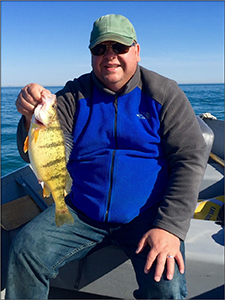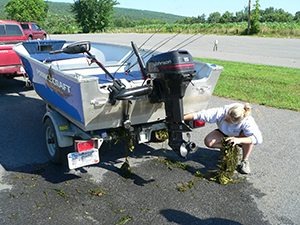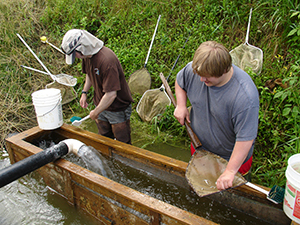The Fishing Line - May 19th Issue
The New York State Department of Environmental Conservation sent this bulletin on 05/19/2023 02:09 PM EDT |
| DEC Delivers - Information to keep you connected and informed from the NYS Department of Environmental Conservation |
| View in browser |
The Fishing Line - May 19th Issue |
Freshwater Fishing, Fisheries Management, and Fishing Access NewsIn this Issue:
Happy National Wetlands Month!
In 1991, the US Environmental Protection Agency (EPA) declared May "National Wetlands Month" to bring awareness to these amazing ecosystems. Wetlands are vital to fish populations. Fish need food, cover, clean water, and a safe place to raise their young, just like humans. The functions of wetlands provide all these things! FOOD - Wetlands have been referred to as “nature’s supermarket” because they provide a plentiful food supply due to their rapid plant production. COVER - The thick plant growth and dense vegetation allow adult and juvenile fish to hide from predators. The root systems of trees and shrubs in floodplain wetlands allow stream banks to hang over the water, providing even more protective habitat for fish. CLEAN WATER - Wetlands filter out harmful pollutants that became trapped in the vegetation and then stored within the layers of sediment. Other pollutants are transformed into less harmful forms by wetland plants and small organisms called microbes. SAFE PLACE TO RAISE YOUNG - Many adult fish use wetlands to lay their eggs. Vulnerable eggs can be hidden from predators in thick vegetation. The detritus, organic matter made by the decomposition of organisms, acts as both a protective cover for the eggs and food for the larva after they hatch. Sadly, New York is thought to have lost 60% of its total wetlands since 1780. Increased development and continued conversion of wetlands to other uses result in wetlands being degraded or destroyed. As a result, it becomes more difficult for fish to find the habitats they need. You can help by becoming a “wetland warrior,” locate where there is a wetland near you and spread the word about how important they are! Find a wetland near you: Photo credit: The Wetland Trust Lake Erie Open Lake Angler Survey Update - April 2023
Spring yellow perch fishing on Lake Erie is in full swing! Almost 80% of Lake Erie anglers were after yellow perch this April! Anglers were rewarded with an average harvest of 33 perch per boat and a catch rate of 2.6 perch per hour, which are both well above average (14.1 per boat; 1.5 per hour). Just over 7% of April yellow perch anglers achieved a 50-fish limit with an average length of 11.6 inches. Good perch fishing should continue through May. Anglers out targeting pre-spawn smallmouth bass also found success, catching bass at a rate of 1.65 fish per hour, which is well above the survey average of 1.05 per hour. The walleye season opened on May 1 and the fishing should continue to heat up as the month progresses!
Prevent the Spread of Aquatic Invasive Species
With boating season upon us, it's important to remember to help prevent the spread of aquatic invasive species (AIS) using the "clean, drain, dry" method for boats, as well as disinfecting fishing gear. Beginning Memorial Day weekend, boat stewards will be available at more than 200 launches across the state to educate and assist boaters in practicing these techniques every time they come off the water and prior to launching. AIS Prevention Tips:
Boating in the Adirondack Park: As of June 2022, all boaters operating any kind of motorized watercraft in the Adirondack Park and within ten miles of the Blue Line are required by law to possess certification that their vessel has undergone the proper cleaning measures to prevent the spread of aquatic invasive species. Boaters can get their certification from a boat steward at a DEC-designated inspection station or by completing a self-issued certificate (PDF) prior to launch. Have questions about this regulation? See our Frequently Asked Questions (PDF) Hatchery Highlight - South Otselic Fish Hatchery
Location: South Otselic, Chenango County Visitor Hours: 8:00 a.m. to 3:00 p.m., Monday through Friday, year-round Species Raised: Walleye, Brook Trout Overview: Every year, South Otselic receives 335,000 walleye fry from Oneida Fish Hatchery and raises them in 10 earthen ponds until they reach fingerling size where they're stocked in approximately 14 waters around the state. Heritage (original) strain brook trout and "Temiscamie" (a hybrid, with better survival rates in acidic waters) brook trout are also raised here. Outside of the hatchery, South Otselic staff are also heavily involved with the annual walleye egg take at Oneida Fish Hatchery and the Cayuga Lake egg take, which supplies Seneca strain lake trout for stocking throughout the state. Fun Fact: The hatchery was built in 1932 by 50 laborers from the City of Norwich, Chenango County, and NYS employees. Initially, black bass were raised here. |




